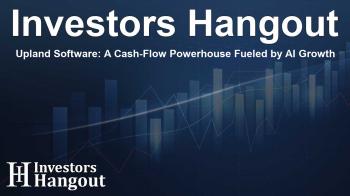Upland Software: A Cash-Flow Powerhouse Fueled by AI Growth

Upland Software's Transformation into a Cash-Rich Entity
Upland Software has been gaining traction as a lean, cash-generating player in the software industry. Analysts have noted the company's ability to stabilize its operations and strategically navigate its future. This shift is evident as Upland continues to focus on innovation, particularly in the realms of debt management and AI advancements.
Analyst Upgrades Highlight Growth Potential
One of the notable analysts covering Upland, Scott Berg from Needham, upgraded the stock from Hold to Buy, setting a price target of $4.50. This target reflects a valuation of 8.0 times the fiscal 2025 adjusted EBITDA. Berg's emphasis on the company's strong cash flow visibility provides an optimistic outlook for investors.
Projecting Annual Free Cash Flow
Berg projects that Upland will generate over $20 million in annual free cash flow (FCF), indicating a healthy financial trajectory. This cash flow is anticipated to grow by more than 10% even without major revenue expansions, largely due to the refined business structure implemented by the management team.
Strategic Focus on Debt Reduction
A significant aspect of Upland's strategy involves debt reduction. The company has a floating-rate credit facility amounting to $240 million, and every $20 million paid off in principal translates into approximately $2 million less in interest expenses annually. This proactive management of debt is perceived as a pivotal growth driver.
Use of Free Cash Flow
The management's current plan is to allocate the majority of their cash flow towards debt repayments, ensuring a minimum 50% cash flow sweep as mandated by covenants. This disciplined approach is seen as vital to enhancing Upland's financial health and growth prospects.
Share Buyback Program and Revenue Focus
Furthermore, Upland plans to implement a $10 million share buyback program within the next year, which will positively impact shareholder value. The company is now primarily engaged in Knowledge and Content Management (KCM), which contributes to 70% of its core revenue and is where future growth opportunities lie.
Leveraging AI for Growth
Berg highlighted Upland's innovative use of AI, which is designed to boost upsell momentum. They are utilizing technology such as call center bots and automated writing tools. The cloud-native approach ensures that Upland minimizes reliance on outdated software licenses, positioning it well for future advancements.
Sales Strategy and Customer Base Expansion
Upland has shifted away from its centralized sales model, adopting a more traditional field sales approach that enhances product expertise and customer acquisition. Although new customer additions have been slower, the net dollar retention rate has climbed to an impressive 99% due to successful upselling techniques.
Forecasting Revenue Growth
With these new strategies and the integration of AI tools, Upland is expected to achieve a core revenue growth rate of over 5%. Management has set ambitious targets, aiming for a 31% EBITDA margin by 2027, with margins projected between 29% and 30% for the fiscal year 2026.
Improving Profitability and Cost Efficiency
Improvements in profitability are already being realized, in part due to R&D outsourcing and decreased investments in front-office operations. The analyst contends that sales and marketing expenses should decrease by 200 to 300 basis points, enabling resource reinvestment in growth initiatives.
FCF Conversion Estimates
Berg estimates a free cash flow conversion rate at about 34% of adjusted EBITDA. There may be temporary compression in fiscal 2026 due to increased interest costs and higher cash tax obligations, but the long-term strategy still looks promising.
Current Stock Performance and Market Outlook
At the time of writing, Upland Software's stock is trading at approximately $2.75, reflecting a recent decline of around 4.02%. Despite this fluctuation, the positive earnings outlook, driven by strategic decisions, indicates potential for future recovery and growth.
Frequently Asked Questions
What is Upland Software's primary business focus?
Upland Software primarily focuses on Knowledge and Content Management (KCM), which accounts for 70% of its core revenue and future growth opportunities.
What is the significance of the cash flow projections for Upland Software?
The projected free cash flow of over $20 million annually is significant as it enables debt reduction and supports further investment in growth initiatives.
How is Upland Software utilizing AI to enhance its services?
Upland is leveraging AI technologies such as chatbots and automated writing tools to improve customer service and boost upselling efforts.
What is the anticipated EBITDA margin for Upland Software by 2027?
Management targets an EBITDA margin of over 31% by 2027, positioning the company for sustainable profitability.
What recent changes have been made to Upland's sales strategy?
Upland has reverted to a field sales model to improve customer acquisition and product expertise, enhancing overall sales effectiveness.
About The Author
Contact Dominic Sanders privately here. Or send an email with ATTN: Dominic Sanders as the subject to contact@investorshangout.com.
About Investors Hangout
Investors Hangout is a leading online stock forum for financial discussion and learning, offering a wide range of free tools and resources. It draws in traders of all levels, who exchange market knowledge, investigate trading tactics, and keep an eye on industry developments in real time. Featuring financial articles, stock message boards, quotes, charts, company profiles, and live news updates. Through cooperative learning and a wealth of informational resources, it helps users from novices creating their first portfolios to experts honing their techniques. Join Investors Hangout today: https://investorshangout.com/
The content of this article is based on factual, publicly available information and does not represent legal, financial, or investment advice. Investors Hangout does not offer financial advice, and the author is not a licensed financial advisor. Consult a qualified advisor before making any financial or investment decisions based on this article. This article should not be considered advice to purchase, sell, or hold any securities or other investments. If any of the material provided here is inaccurate, please contact us for corrections.

